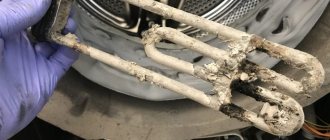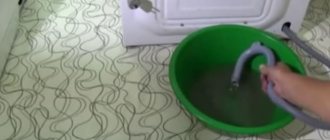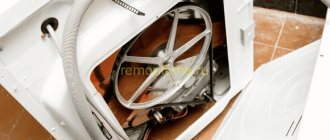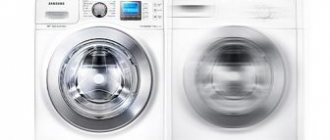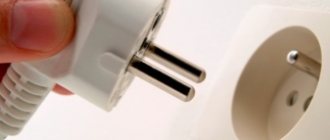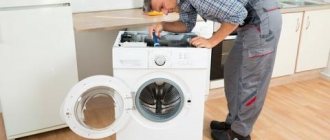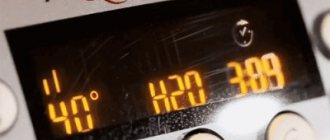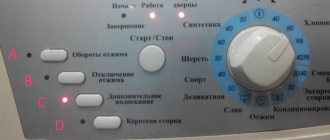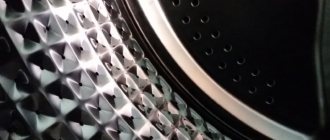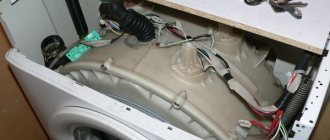Sooner or later, breakdowns happen with any equipment. The washing machine may not turn on, even if it was designed by the most experienced engineers.
Main symptoms:
- The indicators do not light up or they all light up at the same time,
- The washing suddenly stops
- I can't hear the engine running,
- It hums, but the wash does not start,
- The hatch door does not close completely, the lock clicks,
- The control panel reports errors.
All this is certainly scary. But the situation may not be as critical as it first seems. Let's figure out whether the problem is serious and how to fix the “washing machine” with your own hands, saving both time and money.
The manual is universal and is suitable for all vertical and horizontal models of the brands Ariston, Bosch, Candy, Gorenje, Indesit, Samsung, Siemens, Zanussi, Ariston, Bosch, Aeg, Beko, Electrolux, Haier and others.
To start
First of all, you should check the basic reasons why the washing machine does not want to work, and only then move on to more complex diagnostics.
Check electricity
First of all, see if the machine is connected to the network. Even if the plug is inserted into the socket, check the serviceability of the plugs and the socket itself by plugging in, for example, a hair dryer or razor.
Is the plug or cord damaged?
Carefully inspect the electrical cord and plug for integrity, look for kinks, fractures, animal bites, traces of melting, burning and other damage. If the cord or plug is damaged, there is a risk of electric shock, so you need to replace the cord immediately. Until then, it is better to wrap the damaged area with electrical tape. However, this is only an imitation of safety; do not put off repairs.
Is there a water supply
Sometimes the wash cannot start because water does not enter the tank. First of all, check whether the liquid flows normally from the tap. With low pressure, the water will either take a long time to collect water or will not do so at all.
If the water supply is in order, you next need to check whether the water supply valve is open, the condition of the hose through which water enters the unit, and whether the manhole cover is tightly closed.
Another problem with the water supply may mean:
- The lock on the door (UBL) is broken.
- The filter mesh at the connection between the hose and the machine is clogged.
- The intake valve coil is burnt out.
- The water pressure sensor or programmer is broken. The pressure switch sends an incorrect signal to the control module, blocking the filling valve.
- The aquastop system may have worked.
- Full list of reasons in this article:
We fix 15 main problems with washing machines with our own hands
Power button does not respond
Sometimes the machine refuses to turn on precisely because the power button is damaged or stuck. Often the contacts simply oxidize and it stops responding to pressure. This assumption is checked immediately after diagnosing the power cord and interference filter.
To remove the button, you will have to remove the cover of the machine body. Next, the wires are pulled off the key; it is better to photograph the connection diagram - this will help when reinstalling the part. Then you need to pry the latches and pull out the button.
First, the removed button is probed with a multimeter. Then the resistance it produces is checked. If a problem is identified, the part will have to be replaced. Sometimes the problem can be solved by cleaning the contacts, so technicians recommend trying this option. Even if after this the key does not ring, you will have to replace it.
Main reasons
Here are more serious causes of malfunctions why the machine does not turn on at all:
- Voltage fluctuations in the network.
- Moisture penetration into electronics.
- The destructive influence of low-quality household chemicals.
- Mechanical damage.
Due to all of the above, the washing machine may break down. Fortunately, this is not always critical. In some cases, it is quite possible to fix the breakdown yourself, but in others, you will have to contact an equipment repair specialist.
The hatch door does not lock
It happens that the machine door stops closing or does not lock tightly. The principle of the lock (UBL) installed on the door is that while it is open, the program does not start washing. It is important to remember that if the door is in order, when closing the lock should click and a characteristic sound will be heard.
Reasons for failure:
- Warping of the hatch over time or displacement of parts in the lock;
- Natural wear of the door seal (cuff) or plastic;
- Damage to the hatch locking device (UBL);
To determine what's wrong, try closing the hatch with an empty drum and starting the machine.
Indicators do not light up
If no lights on the washing machine panel come on, most likely:
- power button is broken;
- The programmer or control module does not work;
- no power supply;
- The interference filter (installed inside the case) is broken - this happens if the ground is not connected.
In such cases, it is better to contact a specialist - the intervention will be serious and experience is needed.
The indicators are on, but the wash does not start
Here are some reasons for this malfunction:
- Excess weight. Do not overload with loading; if you throw in too much laundry at once (more than 6 kg), the machine may not be able to pull. It's better to wash things a couple of times. In some models, there is an LED indicator of the same name for this case, and in some there is a sound signal similar to beeping.
- The drive belt is frayed, stretched or torn. Occurs from natural wear and tear or long periods of inactivity. Sometimes this is accompanied by a humming sound from the engine when idling. There is only one way out: you will have to change the belt.
- A foreign object could be stuck between the drum and the housing, interfering with movement. Sometimes in such cases a grinding or knocking noise is heard, but it happens that the drum simply does not spin, as it is blocked by a foreign object.
- The heating element is faulty. Such a breakdown occurs due to a sudden stop of the machine: for example, due to a power outage or power surges. Another reason is that the pressure switch is faulty and does not fill the required volume of water. Because of this, the heating element works in the air, runs idle and burns out. Subsequently, the water does not heat up. The assembly part will need to be replaced.
- Bearing wear. All parts and components of the unit are subject to natural wear and tear and may fail at the end of their service life - usually more than 5-7 years. The tank axis becomes warped, the drum rubs against the tank or stops altogether. Then you have to disassemble the machine and replace the elements with new ones.
- The transport bolts have not been removed.
- Engine malfunction. This is the most difficult, but, on the other hand, the rarest problem. This can only happen from a sudden drop in electricity or water leaks into the electrical part, followed by short-circuiting of the motor armature winding. A break in the rotor or stator winding also occurs. In such a situation, we recommend that you immediately call a specialist or take the unit to a service center - you may be able to take advantage of the warranty.
- Electronic module malfunction. When the control electronics break down, no signals are sent to the different components of the machine. This happens due to voltage surges or long-term use of equipment. In this case, the board needs to be changed or reflashed, depending on the complexity of the problem.
Indicators blink randomly
Most likely the cause is a faulty control board. Random blinking of LEDs occurs as a result of a voltage drop or liquid entering the microcircuit. Usually the board is sealed at the factory with an adhesive compound, but during repairs this layer is sometimes damaged, which leads to fatal consequences.
Damage to internal wiring and parts
A washing machine is a complex mechanism that requires careful handling. Only this will avoid damage that could harm mechanisms and parts both inside and outside. When transporting – especially for used equipment – you should shake the unit as little as possible, especially if you don’t drop it when unloading or loading.
The main troubles that await the machine if it is transported incorrectly:
- damage to electrical wiring;
- deformation of plastic parts and components;
- door damage;
- damage to handles and control buttons;
- Sensor failure;
- torn wires and hoses.
Inlet valve faulty
With this breakdown, either there is no water supply to the drum, or vice versa - water is drawn into the tank without stopping and overflows it. This threatens a flood or, at best, a puddle on the floor.
- If the liquid does not flow, it is worth checking whether the mesh at the inlet is clogged. If there is a blockage, just unscrew the stinking hose and clean the plastic filter from large debris.
- It happens that the filler valve jams due to age or due to excess debris on the membrane. Then the liquid flows freely into the washing machine, even if it is unplugged. The opposite situation is that the winding of the solenoid valve burns out and the supply channel does not open. Only replacing the element will help here.
Read more about this problem here:
How to fix the fill valve in a washing machine with your own hands
Engine burned out
A rare malfunction, but it still happens, more details here:
10 reasons why the washing machine shakes and rattles during the spin cycle
The belt has fallen off or the bearing has fallen apart
If you hear the electric motor running, there is a characteristic “hum”:
- The belt fell off the pulleys,
- The drum is jammed.
If such troubles occur, read the recommendations described in this article:
Instructions on what to do if the washing machine does not spin clothes
Problems with the pressure switch
A pressure switch is a sensor for the level of water collected in a washing machine, on which the pressure depends. If it breaks down, the equipment spontaneously stops in the middle of the work process. Different programs and cycles in the unit require different amounts of water. Sometimes the tube leading from the tank to the sensor gets clogged, then you can really do it on your own. Read how to do it yourself here:
The pressure switch in the washing machine is broken: what to do?
Water got on the electronics
If internal leaks occur from valves, pipes, hoses, very serious damage can occur. In addition to the fact that the electronics stops correctly sending commands to various components and software failures occur, a short circuit can occur, which will lead to a fire. A characteristic sign: the washing machine turns on and then turns off immediately.
If liquid gets on the windings or brushes of the main motor, there is a possibility that the motor will no longer start.
If you see a puddle on the floor, do not run the wash under any circumstances. Pull the plug out of the socket, find out where the leak is or call a technician.
Make sure that the machine stands level, and when moving, always remove the drawer for adding detergents. There remains a little liquid, which will definitely flow onto the board when the equipment is tilted, causing a short circuit. This can lead to board burnout or subsequent oxidation of current-carrying contacts.
The chip burned out
The reason that the washing machine does not turn on may be a damaged microcircuit on the control board. The electronic module of an automatic machine consists of many semiconductors, and it will be difficult for a non-specialist to understand which element has failed. Therefore, it is better to entrust the diagnostics of the microprocessor to a specialist.
Sometimes there are visible signs of damage on the control board, so you can inspect it yourself. To do this you need:
- turn off the power to the machine;
- pull out the powder receptacle;
- Unscrew the screws holding the control panel;
- remove the tidy;
- deal with the latches and disassemble the panel;
- take out the control board.
When disassembling the dashboard, try not to touch the wires so as not to accidentally break them.
After completing disassembly, inspect the control board. If there are no visible damages, most likely we are talking about hidden defects that only a specialist can detect. It is better to transfer the module to a service center for diagnostics and further repairs.
Interesting:
- Indesit washing machine does not turn on
- Haier washing machine won't turn on
- Ariston washing machine does not turn on - reasons
- Whirlpool washing machine errors without display
- Ardo washing machine does not turn on
- Why doesn't the washing machine work?
Reader comments
- Share your opinion - leave a comment
Common Error Codes
Modern models of washing machines are equipped with various sensors, breakdown protection systems and electronic displays, which makes life easier for their owners. If any malfunction occurs during operation, the washing machine will signal this with a special code or by flashing a specific indicator.
If you respond to such a signal in time, you can avoid complex breakdowns and even eliminate the cause of the malfunction yourself.
To begin with, it’s worth looking at the user manual, which is always included with each machine model. The documentation must list all the codes that can be used to determine the breakdown. If the document is lost, then this information can be viewed on the Internet on the manufacturer’s official website. Look for the technical assistance section, there is a table with codes for each model.
Here are codes common to common models. If an urgent emergency arises, they can help:
- 1E - check the water level sensor (pressostat);
- 3E, 3E1, 3E2, 3E3, 3E4 - this set of symbols always indicates that an engine tachogenerator error has occurred;
- 4E, 4E1, 4E2 - check the water supply;
- 5E - check the drain, most likely it is not working or is clogged;
- 8E - the engine does not start or turns off;
- 9E1, 9E2, Uc - problems with the power supply: perhaps a wire is broken somewhere or the failure occurred due to a power surge;
- AE - communication error. This means that the integrity of the control board is compromised and, as a result, the signals do not pass through;
- bE1, bE2, bE3 - a problem with the buttons on the panel or in the control module;
- CE - error in temperature mode: something with the thermometer or heating element;
- dE (door), dE1, dE2 - hatch blocking error, for some reason the door does not close hermetically. It is worth inspecting the seal and lock;
- HE, HE1 (H1), HE2, HE3 - the problem is in the heating element, the thermal relay may have tripped;
- LE (LE1) - water leak;
- OE (OF) - water does not leave the tank;
- tE1, tE2, tE3 - the heating element heats the water not according to the washing program;
- EE - if there is a drying function, then this code indicates overheating;
- Sud (SUdS) - excess foam.
Checking the serviceability of the socket
There are often situations when the machine does not start the washing cycle because the socket is broken.
The easiest way to check the functionality of the power supply is with an indicator screwdriver. If such a measuring device is not at hand, you can connect other electrical equipment to it (for example, a light bulb or a mobile phone charger). If the power supply connector is working properly, but the washing machine still refuses to start washing, the reason should be looked for in the device itself; for this you will need a multimeter. See also -
Atlant washing machine displays error F3 - what does it mean?
Recommendations for proper care
Any equipment needs to be looked after and a washing machine is no exception. It must be kept clean, tidy and dry at all times. Here are some care tips:
- Periodically wipe the body and interior with a damp sponge and a special detergent. After that, go over with a dry cloth and let the machine dry completely.
- It is advisable to remove the wire and hose from under your feet, especially if there are small children in the house.
- The removable detergent trays need to be cleaned.
- Before washing, do not forget to turn the pockets inside out so that nothing remains in them. For clothes with metal inserts or other hard parts, use special bags.
- Be sure to inspect the centrifuge after washing and spinning. Small hard objects such as buttons, coins or other clothing items caught in it will cause malfunction. Immediately remove any excess from the drum.
- The composition of tap water contains many impurities, so you need to constantly monitor the condition of the drain filter and pump and clean it periodically.
- Wash the inside of the machine with special liquids and run it on a wash cycle without any items. This is what the manufacturer recommends.
- Do not allow scale to form on the heating element.
What to do to avoid problems
It is important to use your washing machine correctly. For this:
- Follow the instructions.
- Don't force your washer to wear out. If you wash several times a day, take breaks for a couple of hours.
- After washing, leave the hatch open and wipe the cuff from mold. Wash the dispenser tray periodically to remove any detergent residue.
- Read the ingredients of the detergents you use so as not to harm yourself and your car.
- Carry out scale prevention, including an empty machine at high temperatures. Use special tools.
By following simple rules, you can extend the life of your equipment.
Let's check the power supply
Often the automatic machine refuses to turn on due to problems with the external power supply. Before you panic, make sure there is light in the room and apartment. Perhaps the power has been turned off throughout the house and you just need to wait until the power comes back on.
Next, pay attention to the electrical panel. Find out if all switches are set to the “working” position. Perhaps, when starting the washing machine, the circuit was overloaded, so the protective shutdown device tripped. It is necessary to turn the machines back on and analyze which electrical appliance in the house should be temporarily disconnected from the network in order to prevent repeated overvoltage and current leakage.
Then the socket is inspected. If you find melted plastic or dark spots on its body and smell a burning smell, immediately stop supplying current to the room by clicking the corresponding switch on the panel. The electrical outlet will need to be repaired.
It is forbidden to use a socket with melted insulation, from which there is smoke or a burning smell - you should immediately turn off the power and call an electrician. When the outlet visually seems intact, try connecting any other electrical appliance to it, for example, a hair dryer. If there is contact, the search for the “problem area” will have to continue.
Malfunction of the command device or control module
If, after diagnostic measures, all indicators remain normal, but the machine still does not start the washing program, the cause may be a failure of the control module or command device. Replacing an electronic module is a fairly expensive repair and it is often easier to purchase a new washing machine. But there are times when it can be repaired. To do this, the contractor must have experience and knowledge of electrical work. If there are none, then you can’t do without a qualified craftsman.
